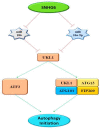LncRNA SNHG6 role in clinicopathological parameters in cancers
- PMID: 37735423
- PMCID: PMC10515066
- DOI: 10.1186/s40001-023-01358-2
LncRNA SNHG6 role in clinicopathological parameters in cancers
Abstract
RNA sequencing has revealed that a substantial portion of the human genome undergoes transcription, yet a minimal fraction of these transcripts translates into proteins. LncRNAs, RNA molecules less than 200 nt in length, once deemed as transcriptional noise, have now emerged as crucial regulators of numerous cellular processes. This review focuses on the lncRNA SNHG6, aiming to elucidate its biogenesis, the pivotal roles it plays, and its mechanisms in facilitating the hallmarks of cancer. A comprehensive literature review and analysis were undertaken to delve into the biogenesis of SNHG6, its roles in cellular processes, and the mechanisms through which it contributes to the hallmarks of cancer. SNHG6 is a notable lncRNA, observed to be overexpressed in various cancer types; its perturbation has been linked to tumor progression, emphasizing its significance in oncogenesis. This lncRNA contributes to a range of cellular aberrations, influencing transcriptional, post-transcriptional, and epigenetic processes of mRNA, ultimately driving cancerous transformations. LncRNA SNHG6 serves as a potential biomarker and therapeutic target due to its association with tumorigenesis. Understanding its mechanism and role in cancer can pave the way for novel diagnostic and therapeutic strategies.
Keywords: Cancer; Epigenetic control; LncRNA; Neoplastic gene regulation; Oncogenes; SNHG6; Signal transduction.
© 2023. BioMed Central Ltd., part of Springer Nature.
Conflict of interest statement
No competing interest.
Figures



References
-
- Clark MB, Mattick JS Long noncoding RNAs in cell biology. In: Seminars in cell & developmental biology, 2011. vol 4. Elsevier, pp 366–376 - PubMed
Publication types
MeSH terms
Substances
LinkOut - more resources
Full Text Sources
Medical
Research Materials

